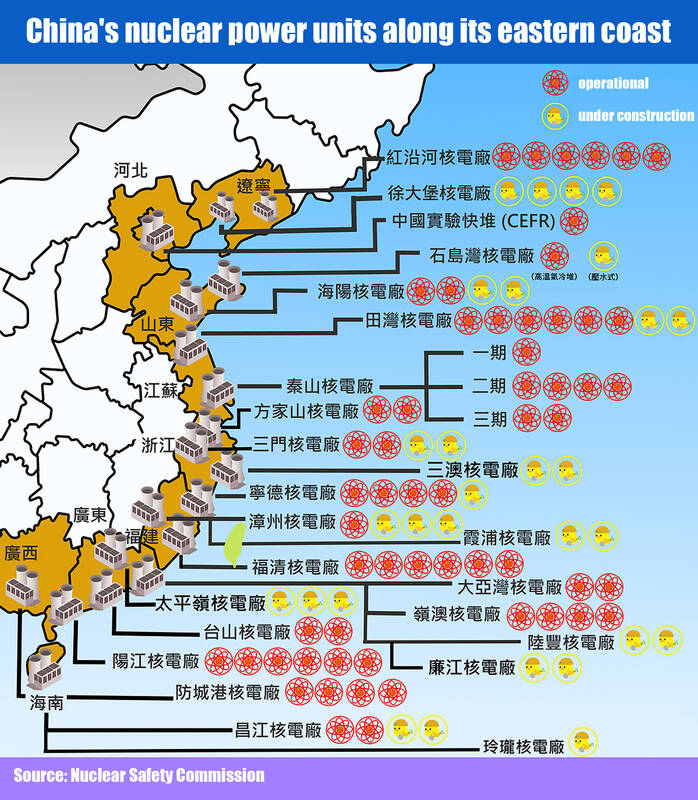Taiwan’s nuclear engineers and the Central Weather Administration (CWA) yesterday said that an earthquake near Kinmen County was less concerning than the potential risk posed by earthquake-triggered tsunamis striking nuclear power plants along China’s coast.
A magnitude 5.0 quake on the Richter scale, the strongest recorded in the Kinmen region in 32 years, struck at 6:56am yesterday.
The CWA said its epicenter was in the Taiwan Strait, about 93.9km east of Kinmen County Hall, at a depth of 17.2km.

Nuclear engineer Ho Li-wei (賀立維) said that while nuclear power plants are designed to withstand strong earthquakes, their cooling systems are more vulnerable.
Ho cited the 2011 Fukushima Dai-ichi disaster, where the plant’s cooling system was damaged by a tsunami triggered by the Tohoku earthquake, ultimately leading to hydrogen explosions that destabilized the facility.
If the same happened to Chinese coastal nuclear power plants, irradiated water could seep into underground aquifers or be carried into the sea, posing a devastating threat to Taiwan’s fisheries, he said.
Kinmen and Lienchiang counties would face particular risk due to their proximity to China, he said.
On the issue of spent fuel pools, Ho said that used fuel rods are stored in pools to dissipate heat and radiation, often requiring years of cooling before they can be transferred to dry storage.
The number of spent fuel rods in pools far exceeds those in active reactors, making them a significant security risk, he said.
CWA Seismological Center Director Wu Chien-fu (吳健富) said that the Kinmen earthquake was not on a fault line and carried little risk of causing a major quake.
Tsunami-generating earthquakes must reach at least magnitude 7 on the Richter scale and occur at depths of less than 30km, Wu said, adding that the likelihood of such conditions arising in the Taiwan Strait is not high.
While the Strait’s shallow waters make it theoretically vulnerable to tsunamis, Wu said that even waves generated by distant quakes would be greatly diminished by the time they reached the area.
Additional reporting by CNA

US climber Alex Honnold is to attempt to scale Taipei 101 without a rope and harness in a live Netflix special on Jan. 24, the streaming platform announced on Wednesday. Accounting for the time difference, the two-hour broadcast of Honnold’s climb, called Skyscraper Live, is to air on Jan. 23 in the US, Netflix said in a statement. Honnold, 40, was the first person ever to free solo climb the 900m El Capitan rock formation in Yosemite National Park — a feat that was recorded and later made into the 2018 documentary film Free Solo. Netflix previewed Skyscraper Live in October, after videos

NUMBERS IMBALANCE: More than 4 million Taiwanese have visited China this year, while only about half a million Chinese have visited here Beijing has yet to respond to Taiwan’s requests for negotiation over matters related to the recovery of cross-strait tourism, the Tourism Administration said yesterday. Taiwan’s tourism authority issued the statement after Chinese-language daily the China Times reported yesterday that the government’s policy of banning group tours to China does not stop Taiwanese from visiting the country. As of October, more than 4.2 million had traveled to China this year, exceeding last year. Beijing estimated the number of Taiwanese tourists in China could reach 4.5 million this year. By contrast, only 500,000 Chinese tourists are expected in Taiwan, the report said. The report

Temperatures are forecast to drop steadily as a continental cold air mass moves across Taiwan, with some areas also likely to see heavy rainfall, the Central Weather Administration (CWA) said. From today through early tomorrow, a cold air mass would keep temperatures low across central and northern Taiwan, and the eastern half of Taiwan proper, with isolated brief showers forecast along Keelung’s north coast, Taipei and New Taipei City’s mountainous areas and eastern Taiwan, it said. Lows of 11°C to 15°C are forecast in central and northern Taiwan, Yilan County, and the outlying Kinmen and Lienchiang (Matsu) counties, and 14°C to 17°C

STEERING FAILURE: The first boat of its class is experiencing teething issues as it readies for acceptance by the navy, according to a recent story about rudder failure The Hai Kun (海鯤), the nation’s first locally built submarine, allegedly suffered a total failure of stern hydraulic systems during the second round of sea acceptance trials on June 26, and sailors were forced to manually operate the X-rudder to turn the submarine and return to port, news Web site Mirror Daily reported yesterday. The report said that tugboats following the Hai Kun assisted the submarine in avoiding collisions with other ships due to the X-rudder malfunctioning. At the time of the report, the submarine had completed its trials and was scheduled to begin diving and surfacing tests in shallow areas. The X-rudder,